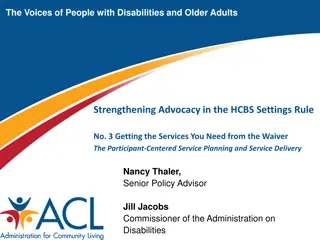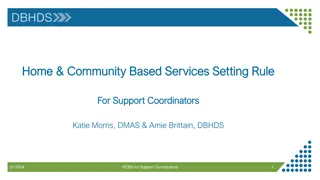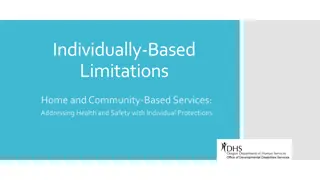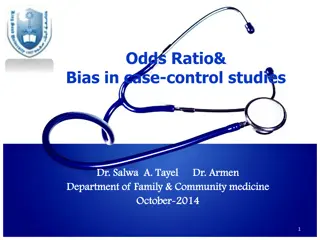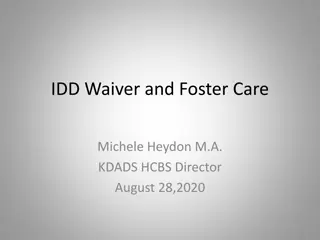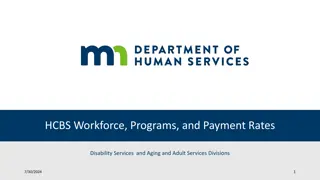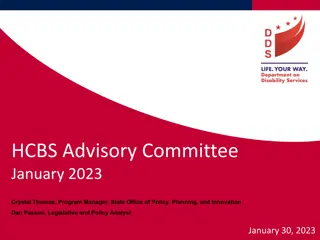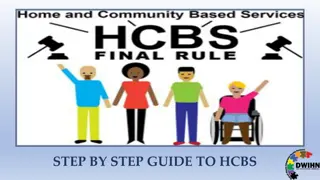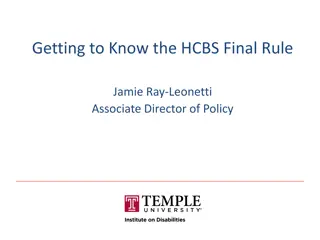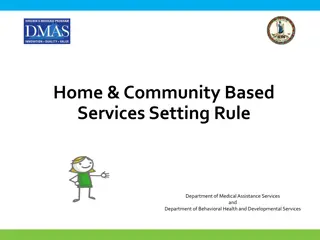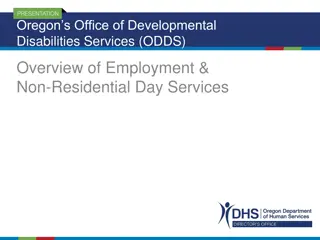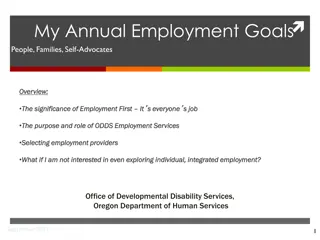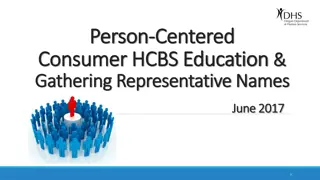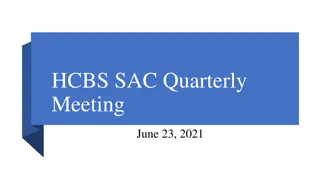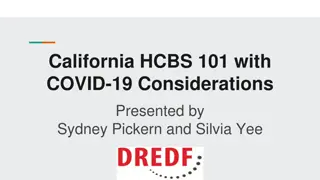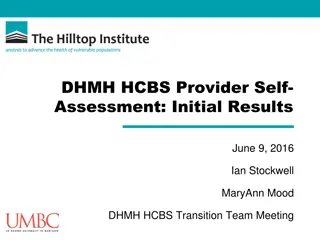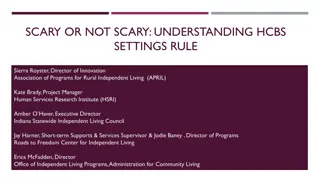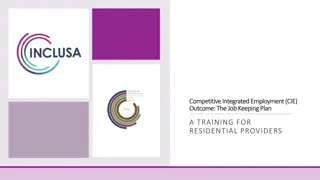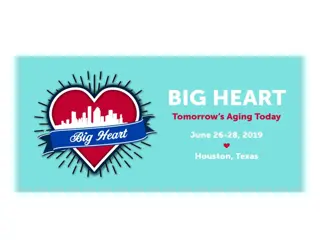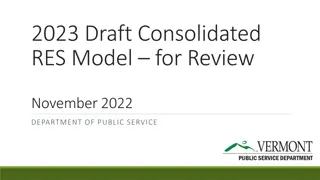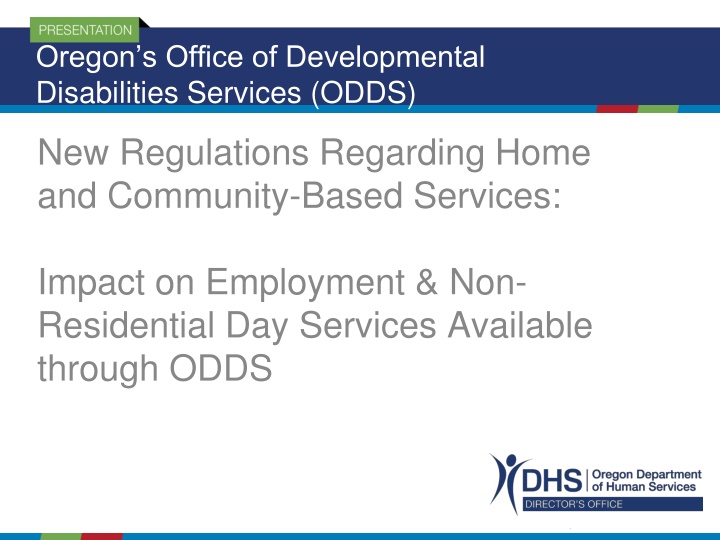
Impact of ODDS Regulations on Home and Community-Based Services in Oregon
Explore the new regulations by Oregon's Office of Developmental Disabilities Services (ODDS) affecting employment and non-residential day services. Learn about the changes impacting Medicaid-funded services, employment opportunities, and the importance of inclusive workforce practices. Discover how ODDS is promoting competitive integrated employment and supporting individuals in community settings.
Download Presentation

Please find below an Image/Link to download the presentation.
The content on the website is provided AS IS for your information and personal use only. It may not be sold, licensed, or shared on other websites without obtaining consent from the author. If you encounter any issues during the download, it is possible that the publisher has removed the file from their server.
You are allowed to download the files provided on this website for personal or commercial use, subject to the condition that they are used lawfully. All files are the property of their respective owners.
The content on the website is provided AS IS for your information and personal use only. It may not be sold, licensed, or shared on other websites without obtaining consent from the author.
E N D
Presentation Transcript
Oregons Office of Developmental Disabilities Services (ODDS) New Regulations Regarding Home and Community-Based Services: Impact on Employment & Non- Residential Day Services Available through ODDS
Background ODDS and Medicaid-funded Home and Community-Based Services Jointly administered and funded through federal & state programs. Currently, the federal government matches Oregon funds by contributing approximately 65% of the cost for these services. ODDS funding streams through the HCBS program include: 1915(c) Waivers fund ODDS Employment Services. Oregon s Community First Choice 1915(k) plan (commonly referred to as the K Plan ) fund non-residential day services (also known as Day Support Activities, ATE, or Community Inclusion), transportation services, attendant care in an employment setting, and some other services that are ancillary to employment services. Note: 1915(c) and 1915(k) refers to the sections of the Social Security Act that provide authority for these programs and funding.
Overview of changes impacting employment and day services Executive Order 15-01 & Integrated Employment Plan Employment First CMS Waiver Expectations Policy Lawsuit Settlement & ADA W.I.O.A. HCBS Integrated Setting Regulations
Overview of changes impacting employment and day services (cont.) And most importantly: Support needs of individuals working or looking to work at general community businesses. Businesses & communities benefit from an inclusive workforce.
ODDS Employment Services: The optimal and expected outcome of all ODDS employment services is competitive integrated employment. Supported Employment (Individual & Small Group) Individual Supported Employment Initial and ongoing job coaching in competitive integrated employment Job development in a competitive integrated job Small Group Supported Employment Discovery Employment Path (Facility or Community)
Settings that are HCBS All Settings in which Home and Community-Based Services are provided must: Be integrated in and support access to the greater community. Ensure individuals receiving Medicaid HCBS have the same access to the greater community as individuals not receiving Medicaid HCBS. Provide opportunities to: Seek employment and work in competitive integrated settings; Engage in community life; and Control personal resources. Ensure individual rights of privacy, dignity, respect, and freedom from coercion and restraint. Optimize, but does not regiment, individual initiative, autonomy, self- direction, and independence in making life choices including, but not limited to, daily activities, physical environment, and with whom to interact. Facilitate individual choice regarding services and supports, and who provides the services and supports.
Settings that are not Home and Community-Based HCBS settings do not include the following: A nursing facility; The Oregon State Hospital; An intermediate care facility for individuals with intellectual disabilities; A hospital providing long-term care services; or Any other setting that has the qualities of an institution. 7
Settings that are Institution-Like The following settings are presumed to have the qualities of an institution: A setting that is located in a building that is also a publicly or privately operated facility that provides inpatient institutional treatment; A setting that is located in a building on the grounds of, or immediately adjacent to, a public institution; or A setting that has the effect of isolating individuals receiving HCBS from the broader community. 8
Application of HCBS regulations to Employment Services & Non-residential Community Living Supports
Settings must provide opportunities to seek employment and work in competitive integrated employment settings Competitive Integrated employment means: Minimum Wage or Better; also no less than the customary rate paid by the employer for the same or similar work performed by coworkers who do not have disabilities, completing the same or similar work and who have similar training, experience, and skills. At a typical community location in the competitive labor market (not a setting designed to employ people who have disabilities) where there are opportunities to interact with other co-workers who are not individuals with disabilities (not including supervisory personnel) to the same extent that individuals who are not individuals with disabilities and who are in comparable positions interact with other persons; and for the purposes of performing work.
Settings must provide opportunities to seek employment and work in competitive integrated employment settings ODDS Job Coaching must be provided in Competitive Integrated Employment Settings. This is the optimal and expected outcome of all other ODDS employment services. Other ODDS Employment Services: Employment Path, Small Group, Discovery, and Job Development. These services and settings must provide opportunities to seek employment and work in competitive integrated settings. This is consistent with 2011 guidance from CMS under which the optimal and expected outcome of all ODDS employment services is competitive integrated employment.
Employment Path at Provider Sites / Facilities Employment Path has the effect of isolating individuals with disabilities from the broader community (and is therefore not HCBS) if the provider site or facility does not: At minimum, provide interaction with the general public. (i.e. provide opportunities to work with customers or coworkers who do not have disabilities or use HCBS). This is also necessary to ensure the setting supports opportunities to seek employment and work in competitive integrated employment settings. Employment services must be individualized and include a plan to integrate individuals into the broader community. Reverse integration alone is insufficient. States may set higher standards. Under Oregon Administrative rules and Oregon s Statewide HCBS Transition Plan, Employment Path settings must come into compliance by 09/01/2018. Note: Job coaching, discovery, job development, and small group are already required to be provided in settings that are in full compliance.
HCBS: Impact on ODDS Employment Path Services Settings that provide few or no interactions with the general public (i.e. Sheltered Workshop settings) are isolating and therefore not HCBS. This includes Sheltered Workshop settings and other settings determined to provide few or no opportunities to interact with the general public. These settings must transform to come into compliance. Research shows that sheltered workshop settings do not support people to get a job in the general workforce. Only 5 percent of sheltered workshop employees leave to take a job in the community, according to a 2001 investigation by the Government Accountability Office. 13
HCBS Compliance ODDS Employment Settings that are generally in full compliance: Job Coaching, Job Development, Discovery, Small Group, Employment Path Community that is not at a provider site. ODDS Employment Settings in Substantial Compliance These settings must develop HCBS Plan of Improvement to ensure full compliance or come into full compliance. Employment Path Facility (not sheltered work) , Combination of DSA at a provider site, Employment Path Community at Provider Site, Employment Path Facility (not sheltered work). ODDS Employment Settings Not in Compliance These settings must transform to come into compliance. Employment Path Facility in Sheltered Workshop settings. 14
Anticipated HCBS Compliance ODDS Employment Settings in Full Compliance By definition, required to be in settings that are in full compliance. e.g. Job Coaching, Job Development, Discovery, Small Group. ODDS Employment Settings in Substantial Compliance Must develop HCBS Plan of Improvement to ensure full compliance or come into full compliance. E.g. Employment Path Facility (not sheltered work) E.g. DSA Facility / Community E.g. Employment Path Community at Provider Site (where some integration, although does not meet requirements to be considered Competitive Integrated Employment) ODDS Employment Settings Not in Compliance Must Transform to come into compliance. E.g. Sheltered Workshop settings. 15
HCBS Transformation Plans & Plans of Improvement A full transformation to job coaching, job development, and discovery, in general workforce settings, and away from the provider site, is the best way to guarantee full compliance now and in the future. Settings that are marginally compliant or non-compliant (CMS and ODDS cannot guarantee that these settings will be considered compliant): Employment path services at a provider site. However, these services must be individualized and include a plan to integrate individuals into the broader community. Reverse integration is insufficient. Day service settings that don t facilitate opportunities for individualized planning and inclusive participation in the broader community. 16
Community Living Supports (DSA/ATE) at Provider Sites or Facilities Facility-based day services offered at a provider site must: At minimum, facilitate opportunities to go out into the broader community. Must facilitate opportunities for individualized planning and participating in the broader community. Note: It is anticipated that ODDS day service settings are in substantial compliance. Some changes may be necessary to reach full compliance.
HCBS: Non-disability specific setting options Individuals must also have an option to use employment and day services in a non-disability specific setting (ie not at a provider site or a setting that is not designed to hire people who have disabilities). The non-disability specific setting option presented must be documented in the person-centered plan (ie the ODDS ISP and CDP).
HCBS: Non-disability specific setting options Employment Services If the person selects employment path services at a provider site or facility, then community-based options must be presented and encouraged, such as Employment Path in the community, Vocational Rehabilitation referral & job development, Discovery, workforce career center, internship or other time-limited work experience in the general workforce. Day Services ODDS anticipates full substantial compliance with this requirement. However, some work may be needed to confirm full compliance. Day service settings must facilitate going out into the broader community. Therefore, DSA Community should always be authorized with DSA Facility.
Oregons Global Transition Plan http://www.oregon.gov/dhs/seniors-disabilities/HCBS/Pages/Index.aspx Providers and sites that are licensed, certified, or endorsed prior to January 1, 2016 will be allowed time to come into compliance. All settings must be in full compliance with the new rules by September 2018. All new providers and sites (including any new construction) being licensed, certified, or endorsed on or after January 1, 2016, must be in full compliance with the new HCBS rules. New CMS regulations incorporated in Oregon Administrative Rules - Effective on January 1, 2016. 9
Timeline for Developing a Provider HCBS Transformation Plan or HCBS Plan of Improvement April December 2015 January 2016 Provider Self-Assessments Completed and Individual Experience Assessments Completed. Providers receive initial determination of HCBS compliance based on Provider Self- Assessment. Sheltered Workshop providers received individualized written notification that sheltered workshop settings are not in compliance with HCBS. Would need to be developing Provider HCBS Transformation Plan to come into compliance. Many sheltered workshop providers already participating in Employment First transformation grant and technical assistance project. Onsite reviews to employment and day service provider sites. Completed by ODDS Regional Employment Specialists with specialized experience and skills in employment services. January 2016 December 2016 Note: Sheltered Workshop settings had onsite reviews completed during Spring 2015 as part of the Sheltered Workshop determination process. June July 2016 ODDS review results from onsite reviews, provider self-assessments, and individual experience surveys. Providers to begin receiving notification regarding areas of non-compliance with a provider scorecard. Notification of need to complete Provider HCBS Plan of Improvement. Those whose onsite visits are completed June 15 or before will receive notification by July 1, 2016. Those whose onsite visits are completed after June 15 will receive notification within 30 days. Timeframe for ODDS review / approval of Provider HCBS Transformation Plans and HCBS Plans of Improvement Reassessment and monitoring implementation of Provider HCBS Transformation Plans and HCBS Plans of Improvement Providers must be in full compliance with HCBS setting requirements Notices to individuals whose sites are not in full compliance August 2016 February 2017 September 2016 September 2018 September 31, 2018 October 2018
QUESTIONS? Contact Information: Allison Enriquez allison.enriquez@state.or.us Regional Employment Specialists: Nate Deeks: Portland/North West Oregon nathan.a.deeks@state.or.us Brad Collins: Eugene/Mid-Valley bradley.c.collins@state.or.us Theresa Knowles: Eastern Oregon theresa.m.knowles@state.or.us Erica Drake: Bend/Central Oregon erica.drake@state.or.us Melanie Hartwig: Roseburg/Southern Oregon melanie.l.hartwig@state.or.us 22
Resources ODDS Employment Service Provider Page: http://www.oregon.gov/DHS/SENIORS-DISABILITIES/DD/Pages/Employment- Service-Provider-Resources.aspx DHS HCBS Transition Plan Website: http://www.oregon.gov/dhs/seniors-disabilities/HCBS/Pages/index.aspx ODDS Provider and Partners Page: https://www.oregon.gov/DHS/SENIORS-DISABILITIES/DD/PROVIDERS- PARTNERS/Pages/index.aspx ODDS/DHS Employment First Initiative Website: http://www.oregon.gov/dhs/employment/employment-first/Pages/index.aspx Executive Order 15-01: http://www.oregon.gov/gov/Documents/executive_orders/eo_15_01.pdf

